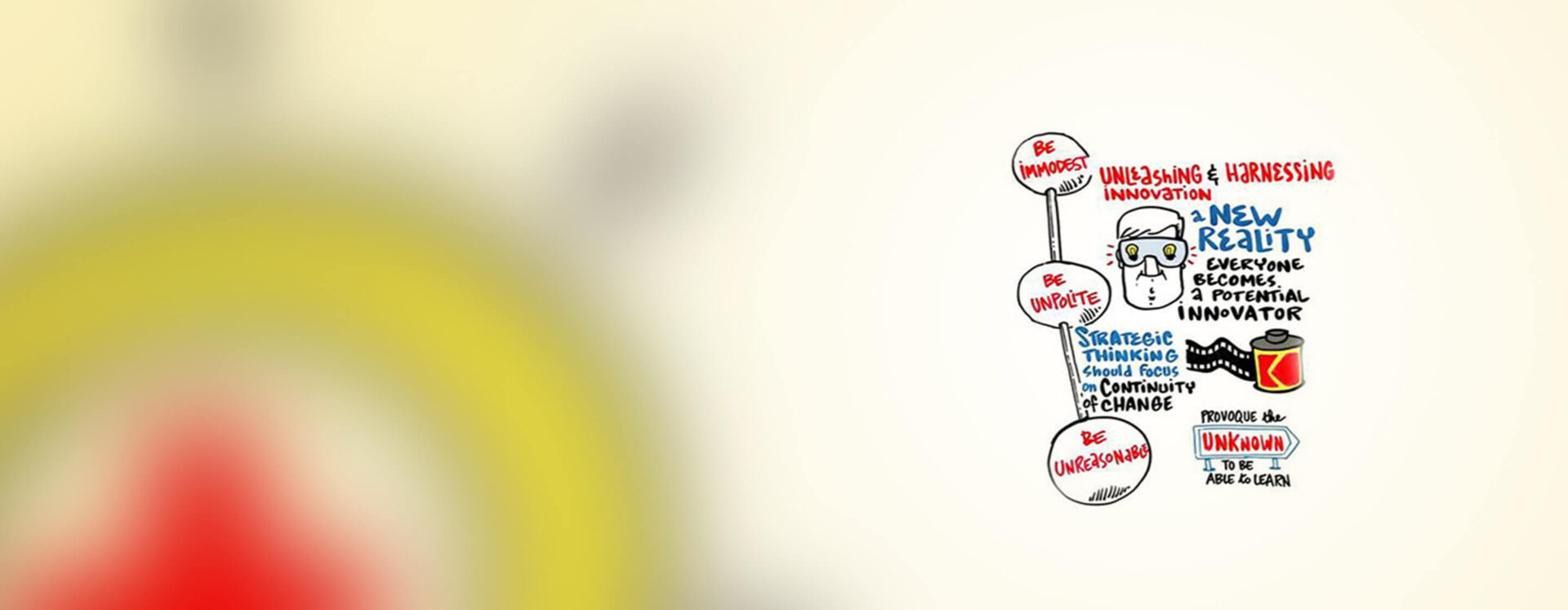
Global partnerships for humanitarian impact and innovation (1): Nobody
can do it alone
In October 2014, 90 leaders from the private sector, academia, research institutes and humanitarian organizations participated in an event at IMD that launched the Global Partnerships for Humanitarian Impact and Innovation (GPHI2) initiative. The event was the first in a series of initiatives on specific themes that will be held in 2015 to foster in-depth discussions and support concrete outcomes. This will be accompanied by the launch of tools, such as an ICRC ideation platform, to facilitate the cocreation and testing of new solutions. Stay informed by following the GPHI2 blog.
The Global Partnerships for Humanitarian Impact and Innovation (GPHI2) – an initiative by the International Committee of the Red Cross (ICRC) with support from Fondation Lombard Odier and IMD – aims to promote the development of innovative solutions to humanitarian challenges by harnessing the creative capacity of the private and the humanitarian sectors to meet the needs of conflict victims. This initiative got under way at an event hosted by IMD that included representatives from the private sector, academia and research institutes, as well as leading humanitarian actors from the Red Cross and Red Crescent Movement and beyond. In this insights@IMD we provide key points of the event and explore the changing context of innovative humanitarian partnerships.
Changing global context
The nature of armed conflict and disasters is evolving rapidly and emergencies are more complex than ever. As a result, organizations of all kinds are striving to understand how to continue operating at a time when old assumptions are constantly being called into question. Professor Carlos Braga began by explaining that humanitarian organizations need to understand and adapt to new challenges, opportunities and liabilities if they wish to continue having a meaningful and lasting social impact. The complex state of the world today, and the speed of change in most spheres, requires an even greater capacity to innovate, change and adapt. Innovative organizations in a globalized world are moving beyond simply copying products and services that work in other environments and instead are imagining new futures and creating entirely new products and services.1 These organizations are also guided by clear values and a narrative that is widely understood and accepted.
Humanitarian partnerships and innovation
Yves Daccord, Director-General of the ICRC, argued that the ICRC and other humanitarian organizations are finding it challenging to adapt in a hyper-connected and rapidly changing world in which disruption is now part of daily operations. They cannot face these immense challenges alone – building new types of partnerships is critical. Daccord stated that the ICRC has the ambition to be among the top organizations when it comes to partnerships with the private sector because he believes that businesses, humanitarians and philanthropists can work together to find creative solutions to the world’s most intractable challenges. Sharing these lessons through initiatives such as GPHI2 can lead to more effective humanitarian partnerships and better outcomes for diverse actors in the sector.
ICRC GPHI2 Team
Juan Luis Coderque Galligo
Head of the Corporate Partnerships Unit and GPHI2 Lead
Tarun Sarwal
Head of the Innovation Initiative
Sebastien Chessex
Project Consultant
Renée Zellweger
Deputy Director, Communication and
Information Management
Thomas de Saint Maurice
Policy Adviser, Policy and Diplomatic Unit
Mechthild Rombach
Corporate Partnerships Unit
Innovation – not only of technological factors but also in terms of people, policy and organizational factors – is at the core of building future capacities. The ICRC’s innovation focus is to develop customized and contextualized solutions in close proximity with those impacted by humanitarian disasters. Being on the ground gives the organization legitimacy and also can provide it with a unique lens to understand the real needs of beneficiaries. Daccord stressed that innovation for the ICRC needs to start in the field.
Unleashing innovation
What lessons about innovation can the ICRC and other humanitarian actors learn from the private sector? Professor Bill Fisher asserted that change is no longer occasional and episodic, which alters the way managers should think about organization, deployment of resources, the way they work and leadership. The continuity of change should be at the center of strategic thinking. When and how organizations react will be determined by where they are in the change cycle.
The change cycle shows how organizations adapt and reinvent themselves as industries evolve. Organizations must learn how to innovate to move to the next phase of the cycle. Professor Fischer introduced a number of lessons learned about innovation from a business perspective:
There is a need to get more out of human talent rather than less: Complex organizations hire great people and turn them into average employees. Building new types of organizations will liberate talent rather than imprisoning it.
Embrace change rather than avoiding it: More different minds are better than more of the same. Agility requires instances where you hire for skills and then figure out how to deal with attitudes.
Do it sooner rather than later: It is relatively easier to make big organizational changes during times of high performance. Urgency is critical to ensure that organizations are not being forced to act during times of low performance.
Radical change should be built on the familiar: A big organizational change involves putting routines and protocols in place and being reasonable about following them. Coherence and consistency are necessary for scalability and success.
Routines are not enough for learning: Organizations need to “provoke” the unknown in order to be able to learn. This involves experimentation, prototyping, agile organizations and agile people.
Unleashing and harnessing innovation in organizations involves recognizing that: 1) you are never going to get it right (wrong and fast is better than perfect and forever); 2) somebody has done it already (look around, others are struggling with similar challenges); 3) it does not always have to be new to the world (“Good artists copy, great artists steal”); and 4) you cannot do it by yourself (different ideas are better than more of the same). These lessons can be useful for humanitarian organizations that
have difficulty implementing innovative solutions and do not always have a sense of urgency to adapt their organizations to rapidly changing contexts.
Moving forward
The GPHI2 event, which also explored specific challenges and opportunities related to innovative humanitarian partnerships through participant working groups (see insights@imd #45), was based on the premise that when the experiences and motivations of entrepreneurs, philanthropists and humanitarians meet on common ground, innovative ideas and partnerships can emerge that will help save and improve more lives.
Event participants were generally convinced about the possibilities for humanitarian innovation. Out of the wide-ranging discussions there was an emerging consensus around the following:
Customized and contextualized solutions: Maintain close proximity to people affected by wars and disasters to ensure that innovation is not imposed from external environments.
Change management: Organize the process of change management in a way that is inclusive – iterate as you go along and give people in the field an opportunity to provide input.
Culture change: Be more open about the case for change internally and externally and realize that an innovative culture accepts and learns from failure.
In closing, ICRC President Peter Maurer reiterated that the ICRC is deeply convinced of the need to seek partnerships with private sector actors to respond to growing organizational needs and the changing external environment. He stressed that humanitarians are often driven by a natural curiosity and desire to find solutions to complex problems – and that humanitarians, philanthropists and business people who share their knowledge, experience and expertise, while respecting and understanding each other’s working methods, can create innovative partnerships for humanitarian impact.
Research Information & Knowledge Hub for additional information on IMD publications

With most digital transformation initiatives ending in failure, we explore the formula behind Coca-Cola Eurasia and Middle East’s success.
The case explores the principles and challenges of operational excellence through the experience of Magdi Batato, former EVP of Operations at Nestlé. It examines how he implemented Mission-Directed Work Teams (MDWTs) to empower front-line workers,...

Understand how GenAI is different from other tech innovations and what you can do to harness its power. This book argues that GenAI represents a genuine paradigm shift in technological innovation. The authors, the hosts of the popular podcast ‘Mik...
As uncertainty grows, organizations must rethink how they navigate a volatile world. Rather than relying solely on scenario planning based on historical data, organizations could take a more proactive approach—imagining and shaping distant futures...
Chinese start-up DeepSeek sent shock waves through global markets in January, with its latest artificial intelligence breakthrough causing a nearly $600 billion rout in Nvidia’s market value. The company has since recouped some of those market los...
The colossal wave of downsizing in the last few years is dividing the workplace in two, between the leavers and the survivors. Business has traditionally emphasized the consequences of downsizing on the leavers, sometimes putting in place severanc...

Two senior lawyers give their verdict on the American Arbitration Association's efforts to harness the power of generative AI. They explain why incumbent organizations must seize the opportunities without delay.

It takes more than an occasional yoga class to tackle the problems of burnout, financial stress, and poor mental and physical health. New research reveals which strategies can move the dial on employee well-being.

The implications of generative AI for "knowledge" work are more profound than many of us might think. Organizations need to wake up.
Venture capital and private-equity funding for deep tech promising to address society’s greatest challenges has doubled its share globally in the past decade. Moreover, governments are increasingly prioritizing deep tech, which is often “dual use”...
Research Information & Knowledge Hub for additional information on IMD publications
Research Information & Knowledge Hub for additional information on IMD publications
Research Information & Knowledge Hub for additional information on IMD publications
in Forbes.com 20 February 2025
Research Information & Knowledge Hub for additional information on IMD publications
Research Information & Knowledge Hub for additional information on IMD publications
Research Information & Knowledge Hub for additional information on IMD publications
in I by IMD 6 February 2025
Research Information & Knowledge Hub for additional information on IMD publications
in I by IMD 4 February 2025
Research Information & Knowledge Hub for additional information on IMD publications
Research Information & Knowledge Hub for additional information on IMD publications
in Forbes.com 28 January 2025
Research Information & Knowledge Hub for additional information on IMD publications


